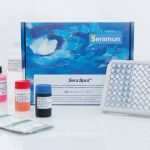Intended use:
The SeraSpot® Anti-EBV-4 IgG / SeraSpot® Anti-EBV-3 IgM test is an in vitro diagnostic device (spotimmunoassay, SIA) for the detection of EBV-specific IgG or IgM antibodies in human serum or plasma samples.
General information:
The Epstein-Barr-Virus (EBV, also known as Human gammaherpesvirus 4) is a small, enveloped, double-stranded DNA virus in the family of Herpesviridae. The DNA contains internal and terminal
repetitive sequences, whereby the terminal sequences enable a ring formation for the DNA replication.
The EBV is the aetiologic agent of the infectious mononucleosis (glandular fever). After a symptomatic or asymptomatic EBV infection the virus could establish a lifelong persistent infection. The virus is mainly transmitted through saliva (contact infection), a transmission through transplantations or blood transfusions is rare. At the age of 4, the infection rate is about 50%, from the age of 20 around 90% and from the age of 50 up to 99%.
An infection during childhood is often asymptomatic, but in case of young adults and adults the infection could lead in 30 to 60 % of all cases to the onset of an infectious mononucleosis. After an incubation time of 10 to 50 days (the average incubation time is 10 to 15 days) the first symptoms could occur. The common symptoms are fever, lymphadenopathy (lymphoma), hepatosplenomegaly (enlargement of the liver and spleen), pharyngitis (sore throat) and tonsillitis. More respiratory symptoms could be dominant in children. In immunocompetent persons the disease is self-limiting and last no longer than 3 weeks.
Especially EBV is associated in immunosuppressed patients with different lymphoproliferative diseases, such as the Burkitt’s lymphoma (lymph node cancer) and nasopharyngeal carcinoma (nose and throat cancer).
During primary infection with EBV, the epithelial cells and B-lymphocytes in the oropharyngeal tract are infected. The virus is spread through the B-lymphocytes in the entire body. The infection could be lytic or latent.
The lytic infection is mainly in epithelial cells and leads to the lysis of the infected cells and the release of virus particles. During the lytic phase regulatory proteins, which belong to the group of “immediately early antigen” (IEA) and “early antigen” (EA), are synthesized to enable the production of the viral DNA,
structural components of the virion (“viral capsid antigen” (VCA)) and membrane proteins (MA). The gene products possess antigenic characteristics and initiate the formation of antibodies.
B-lymphocytes are usually latent infected. The viral genome is in the cell nucleus of the infected cell in an extrachromosomal form (episom). This leads to an immortalization of the B-cells and to the transformation of continuously growing blasts. In immunocompetent persons the growth of the transformed cells is controlled by cytotoxic T-lymphocytes and NK cells. Especially the CD8+ T-cells are directed against antigens of the lytic and latent phase. The immune response is insufficient to disrupt all infected cells. Therefore, the virus can persist in the organism.
During the latent phase, „EBV nuclear antigens” (EBNAs) and 3 latent membrane proteins (LMPs) are expressed in the infected cells. The EBNAs are a complex of at least 6 proteins (ENBA 1-6). EBNA-1 is responsible for the maintenance of the episomal status of the EBV-DNA.
The EBV reactivation, which could occur during the latent phase, is enabled through the recirculation of the infected B-cells in the lymphatic tissue, which are differentiated to plasma cells.
The humoral immune response includes antibodies against antigens of the lytic and latent phase:
Antibodies against EA showing 2 different patterns: a diffuse pattern (EA-D) und restricted pattern (EA- R). EA-D-specific IgG-antibodies are developed during the first 3-4 weeks and are undetectable after 3-4 months. Approximately 85% of the patients with a acute infection are positive for EA-D (up to 3 months after onset of symptoms). In some cases, the antibodies could be detectable over years after a primary infection. During an EBV reactivation (in immunosuppression) and in patients with a nasopharyngeal carcinoma high EA-D-specific antibody titer could be detected.
IgG antibodies against the capsid antigen VCA are developed with the first clinical symptoms of an acute infection remain in the body throughout the life. IgM antibodies are developed in the same time as the IgG antibodies for VCA but disappear within a few weeks.
EBNA-1 IgG antibodies are not detectable during the first 3-4 weeks after onset of the symptoms and are therefore a marker for a past infection. However, 5% of the patients are not producing anti-EBNA-
1. A negative Anti-ENBA-1 IgG result in combination with a positive VCA-IgG, could lead to a false positive diagnosis of an acute infection. In 7% of samples out of the laboratory routine, VCA IgG is isolated reactive. p18 (VCA) is another late marker, which is in contrast with EBNA-1 always produced.
Using 3 parameters (VCA IgG, VCA IgM, EBNA IgG) a differentiation between acute and past infection is in immunocompetent patients usually possible. In immunosuppressed patients is the interpretation of the antibody reactivities is difficult. Due to a failure of the immune system and the fact that the production of the antibodies could differ (depending on the dynamic of the infection), atypical antibody patterns could occur.
In diagnostics commonly used screening tests are Immunofluorescence assays (IFAs), Enzyme Immunoassays (EIAs) and Chemiluminescence Immunoassays (CLIAs), which test for EA IgG, EBNA-1 IgG, VCA IgG and VCA IgM. In IFAs normally EBV-transformed B-cells from patients with Burkitt’s lymphoma are used. In contrast to that, in EIAs and CLIAs purified, native or recombinant proteins, synthetic peptides or fusion proteins are used.
As confirmatory tests Immunoblot assays or Line-Immunoassays are applied, which are using viral lysates from EBV-transformed cells or recombinant antigens. Especially for the differentiation between acute and past infection (in the case, that VCA IgG is positive but EBNA-1 IgG and VCA IgM are negative) Immunoblot assays or Line-Immunoassays are well suitable.
Accessories:
| Art. No. | SP-013-4 G-S6 / SP-013-3 M-S6 |
|---|---|
| Test format | The SeraSpot® Anti-EBV-4 IgG / SeraSpot® Anti-EBV-3 IgM test is a solid phase immunoassay based on the use of recombinant EBV antigens as capture antigens printed in array arrangement (spot array) on the bottom of the wells of 96well-microtiter plates. The recombinant antigens serve as capture molecules for antibodies against EBV antigens. Bound antibodies are detected by horseradish peroxidase-(HRP)-labeled antibodies against human antibodies of IgG- or IgM-type by substrate reaction with hydrogen peroxide and 3,3’,5,5’-tetramethylbenzidine (TMB). At the site of formed immune complexes blue spots are developed by precipitated product from colorless substrate solution. Color intensity correlates to the antibody concentration. Pale blue to dark blue spots are visible by eye. |
| Sensitivity | IgG: 97,7 % IgM: 92 % |
| Specificity | IgG: 97,8 % IgM: 100 % |
Dear customers,
we have started to provide the documents for our products in an electronic format. These are the Instructions for Use (IFU), the Safety Data Sheets (SDS) and the Certificate of Analysis (CoA). For batches placed on the market after 01 January 2023, you can find our documents on the eIFU portal eifu.r-biopharm.com.










